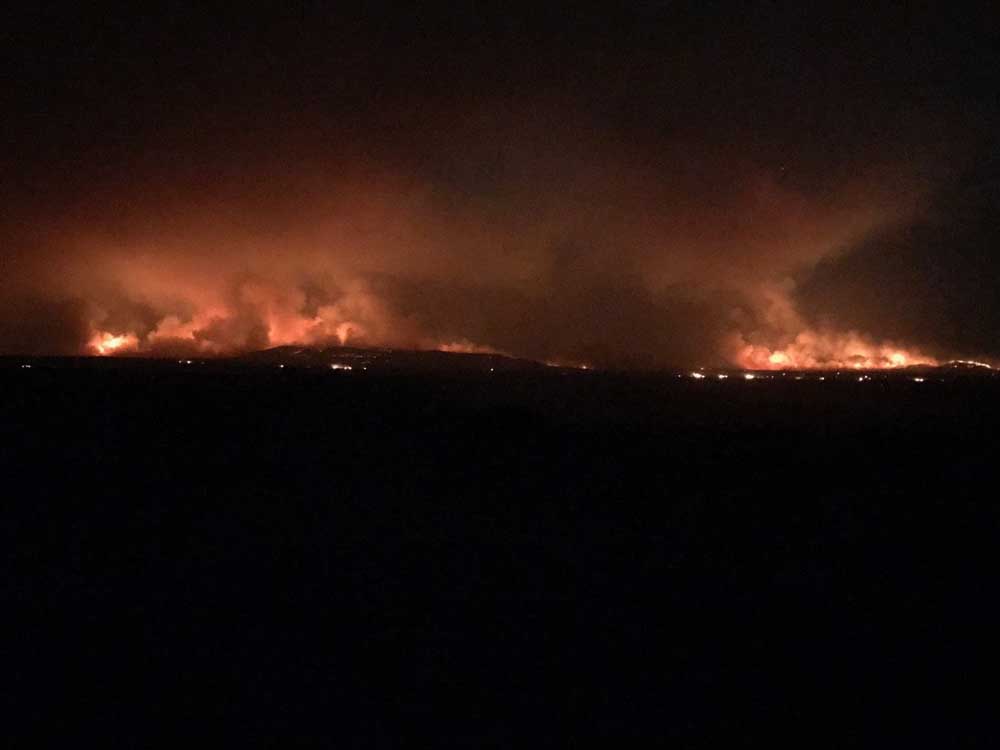Firefighters able to hold off Cinder Butte Fire
Published 5:16 am Wednesday, August 9, 2017

- The Cinder Butte fire Wednesday night. The fire, burning between Bend and Burns, is at 52,000 acres with 9 percent containment. (Submitted photo)
Overnight efforts to extinguish the Cinder Butte Fire limited growth of the rangeland blaze burning between Bend and Burns.
As of Friday afternoon, the fire had burned 52,223 acres.
That’s smaller than the previous 56,000-acre estimate released Thursday, but Nick Cronquist, spokesman for the Northwest Interagency Incident Management Team, said the fire didn’t shrink. Rather, more flights over the fire resulted in a more accurate estimate. There is a 9 percent containment on the fire.
On Thursday the fire reached a size where local resources were no longer adequate. As a result, resources from agencies throughout the Northwest were brought in.
The fire started Wednesday near U.S. Highway 20 about 10 miles west of Riley and quickly took off, burning grass, brush and juniper on mostly Bureau of Land Management land, as well as some private land. It is burning between Highway 20 and U.S. Highway 395.
Cronquist said the fire has moved into drainage areas, making fighting the fire difficult.
“We can’t put firefighters in that neck of the woods,” he said.
Weekend progress could be challenging, he said, as winds are expected to pick up.
“We are working hard, and we have resources coming in from all over the Northwest,” Cronquist said. “Hopefully, weather permitting, we will get ahead of this time.”
Early firefighting efforts consisted largely of driving fire lines with engines to blast the flames with water, as well as using aircraft to drop retardant on the fire.
However, Cronquist said more heavy equipment showed up, and firefighters have been able to cut fire lines. The integrity of those lines will be tested as afternoon winds pick up, he said.
A web page has been created for the fire to provide updates to the public. It can be viewed at https://inciweb.nwcg.gov/incident/5463/.
While the Cinder Butte Fire is by far the largest wildfire in the state, it’s not the only one.
The Whitewater Fire grew by a couple hundred acres Thursday, and as of Friday night had burned 5,000 acres. There is no containment of the fire, but 257 people are working it, along with five helicopters, five masticators — a tractor-like piece of heavy equipment — eight engines, six water tenders and eight bulldozers.
The fire is burning 13 miles east of Detroit in the Mount Jefferson Wilderness. On Thursday, it reached the headwaters of the Breitenbush River.
According to a news release, growth Thursday was stunted due to an inversion layer. Thick smoke grounded aircraft that could have been used to drop water or retardant on the fire.
That smoke, along with several large fires in Western Canada, has filled Central Oregon. However, as of Friday morning air quality had improved throughout the state, according to the Department of Environmental Quality.
While forecasts show smoke will continue to hang in the air throughout the region through the weekend, forecasts also show a slight wind moving to the west. A southeasterly wind mid-week is what pushed smoke from the Whitewater and Canadian fires into the Bend area.
Rob Brooks, meteorologist with the weather service office in Pendleton, said a shift in wind doesn’t mean less smoke settling in Central Oregon.
With fires throughout the state, the direction of the wind doesn’t really matter. Further, he said an inversion over the Bend area could push smoke down to a lower elevation, if it persists.
The shift in wind is not good news for the Whitewater Fire. Despite slightly cooler temperatures Friday, the inversion layer could lift as a westerly wind sets in, creating conditions for extreme fire behavior, the news release said. This includes the torching of trees in the area.
Temperatures are supposed to drop slightly going into the weekend. The weather service has forecast highs in the low 90s and lows in the upper 50s through the weekend for the Bend area. But that doesn’t necessarily mean fire danger is lower, as more people will head out of the city and into the woods to camp, creating the potential for human-caused wildfires.
“From our perspective, there are a lot of ignition sources we want people to be aware of this weekend and throughout the rest of the fire season,” said Kassidy Kern, spokesperson for the Deschutes National Forest.
Kern said even if there were no human-caused fires for the rest of the season, firefighters might have their hands full fighting natural fires.
Because of that, Kern said it’s especially important to take caution. In addition to following fire regulations, Kern said to make sure your propane stove is hooked up properly and the tank is closed off after use. Don’t park hot cars in tall dry grass, fully extinguish cigarette butts and make sure chains pulling boats or RVs don’t drag and create sparks.
“It’s just really a time for everyone to be as aware and vigilant as they can be,” she said.
Area fires have caused several trail and road closures throughout the region. The Whitewater Fire has shut down several trials in the Mount Jefferson Wilderness, and the Spruce Lake Fire in Crater Lake National Park has closed several trails and roads in the park.
Before heading out for a weekend adventure, check with local agencies managing land where you plan to recreate or travel through to ensure trails and roads are accessible.
Next week might not provide much respite either.
Forecasts call for a chance of thunderstorms from Sunday through Thursday. Brooks said the potential for fire will persist.
“It’s just going to be dry; it’s going to be warm, breezy,” he said.
Brooks said there is an expected increase in humidity, resulting in the slight chance of afternoon thunder and lighting next week.
“Lighting is always a concern,” he said.
—Reporter: 541-383-0376, awieber@bendbulletin.com






